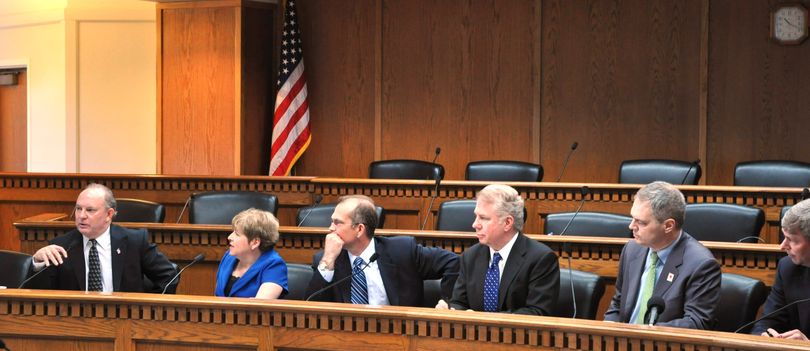Spec Sess Day 29: One budget out, another on the way

Legislative leaders announce proposed 2011-13 general operating budget Tuesday.
OLYMPIA -- Legislative leaders unveiled their latest -- and possibly final -- version of the 2011-13 operating budget they described as painful but sustainable. A deal on the capital budget and changes to the state's debt limit are expected later Tuesday.
The proposed budget, which totals some $32.2 billlion for state programs and salaries, has cuts for every state agency and department. It has pay cuts for state workers and expected cuts for K-12 teachers and other school employees. It cuts but does not eliminate the state's Basic Health program, revamps the Disability Lifeline to end cash grants, cuts higher education but allows the universities and colleges to make up for much of the reduction by raising tuition as much as 13 percent at the University of Washington, Washington State and Western Washington universities, 11.5 percent at Eastern Washington University and 11 percent at community colleges.
The cuts are painful, but in some areas not as bad as earlier proposals, Sen. Ed Murray, D-Seattle, said. Gov. Chris Gregoire's initial budget plan would have eliminated Basic Health and the Disability Lifeline. This proposal saves both, on much reduced levels.
"A budget seems like a math problem, but we all kknow it is really about people," Senate Majority Leader Lisa Brown, D-Spokane, said.
This proposal is more responsible than previous budgets because it does not count on an infusion of federal cash or borrow from other accounts to keep it out of the red, Rep. Ross Hunter, D-Medina, the House Ways and Means Committee chairman said. The safety net is in place, but "it's thinner," he said.
"This is the first budget that does not spend more money that we were forecast to have," Senate Minority Leader Mike Hewitt, R-Walla Walla, said.
The proposal is written as an amendment to the bill sitting in the House of Representatives, where it has been since the start of the special session 29 days ago. It will likely come to a vote in the House later today and move to the Senate. There the vote will await the announcement of details of the state's other big spending package, the Capital Budget, and a possible agreement on plans to reduce the state's debt limit.
Negotiators reached a tentative deal on the Capital Budget at 5:30 a.m. Tuesday, legislative leaders said, and will announce details Tuesday afternoon.
School districts will see a reduction in their state funding that equals a salary reduction of 1.9 percent for teachers and other certified staff, and a 3 percent reduction for administrators. The Legislature doesn't have the authority to cut those salaries, which are part of labor contracts negotiated between the districts and the individual unions. The districts will be able to reopen contracts to seek lower wages, or they could choose to make other cuts.
Those cuts are separate from the suspension of cost-of-living adjustments that voters approved by an initiative in 2000, and a "catch-up" of COLA raises that were suspended in the 2009-11 biennium. Teachers who are eligible for step increases will receive those raises.
Requirements to reduce class sizes, mandated by another 2000 initiative, are suspended, as is a program to reduce class sizes in Grades K through 4. A separate program for smaller K-3 class sizes in high poverty areas did receive money, however.
State employees would receive a 3 percent pay cut through a previously negotiated contract provision that calls for them to reduce work hours by 5.2 hours per month. Management in state agencies are ordered to cut between 7 and 10 percent.
A new system for daily and annual fees at parks, natural lands and other state properties is designed to offset a total of $68 million in total cuts to natural resource agencies such as State Parks, Department of Natural Resources and Fish and Wildlife. The passes, which have already been signed into law, will cost $10 for daily use and $30 for an annual "Discover Pass."
Eligibility in the Basic Health program will be reduced to those who are eligible for Medicaid, and new admissions will be frozen, so the plan will cover about 37,000 people per month in fiscal 2012 and 33,000 in fiscal 2013. The state will also cut payments to hospitals, health centers and rural clinics and emergency rooms being used for non-emergency conditions. It will elimnate the Adult Dental Health program and copayments for Medicare Part D copayments for some clients. It will require families enrolled in the Children's Health Program to pay higher premiums.
The Disability Lifeline program, which currently provides health care and cash grants to disabled people unable to work, is will be replaced with new programs for a savings of about $116 million. The state will continue to provide medical care through other programs, and offer vouchers for housing and essential services to eligible participants through the Department of Commerce.
For details on cuts to the general operating budget, go inside the blog.
Total cuts to wages and salaries: $1 billion including:
$344 million to retired teachers and state employees on Plan 1 retirement programs by canceling a scheduled cost-of-living adjustment.
$266 million scheduled for K-12 teachers under I-732
$179 million through a 1.9% reduction for teachers and 3% reduction to administrative staff in K-12
$177 million through a 3 percent cut for state employees
$61 million from K-12 National Board bonuses
Cuts to education programs $1.1 billion including:
$861 million by suspending I-728 requirements for smaller class sizes
$214 million by dropping a program to reduce class sizes in grades K-4 (but $33.6 million was added to a separate program to shrink class sizes in grades K-3 in high poverty areas.)
$41 million frome the Alternative Learning Experience program
$50 million from changes to the student assessment system
Cuts to higher education of $591 million, including:
$535 million to the colleges and universities
$31 million to state work study programs
$19 million to other financial aid programs
$16.7 million to different State Need Grants to private institutions and for-profit entities
(But $127 million is added to the State Need Grant program overall)
Cuts to state health care programs of $677 million, including:
$129 million from the Basic Health Plan by limiting enrollment to those eligible for Medicaid
$110 million from hospital rate payments
$42 million in payments to health centers and rural clinics
$42 million in Medicaid savings through better oversight
$33 million in cuts by discouraging emergency room visits for non-emergency problems
$29 million from the Adult Dental Services program
$24 million from community health clilnics
Cuts to Long Term Care, Developmental Disability and Mental Health Programs of $228 million, including:
$98 million cut from state payments for personal care of clients
$41 million from nursing home payments
$27 million by delaying training mandated by I-1029
Cuts to Human Services Programs of $274 million, including:
$180 million to the Disability Lifeline by ending cash grants and going to a housing voucher program for the homeless
$33 million from the family leave insurance program
$30 million from the food assistance program
$18 million in child support payments cancelled by federal government
Cuts to state Corrections of $127 million, including:
$12 million by closing McNeil Island
$9 million through early release and supervision changes
Cuts to Natural Resource agencies of $95 million, including:
$68 million to the agencies to be covered by new fees at parks and other state lands
$12 million from the Department of Ecology
In changes to other departments and agencies, state Arts and Heritage programs receive a cut of $11.5 million, but Museum of Arts and Culture in Spokane will stay open on reduced hours.
